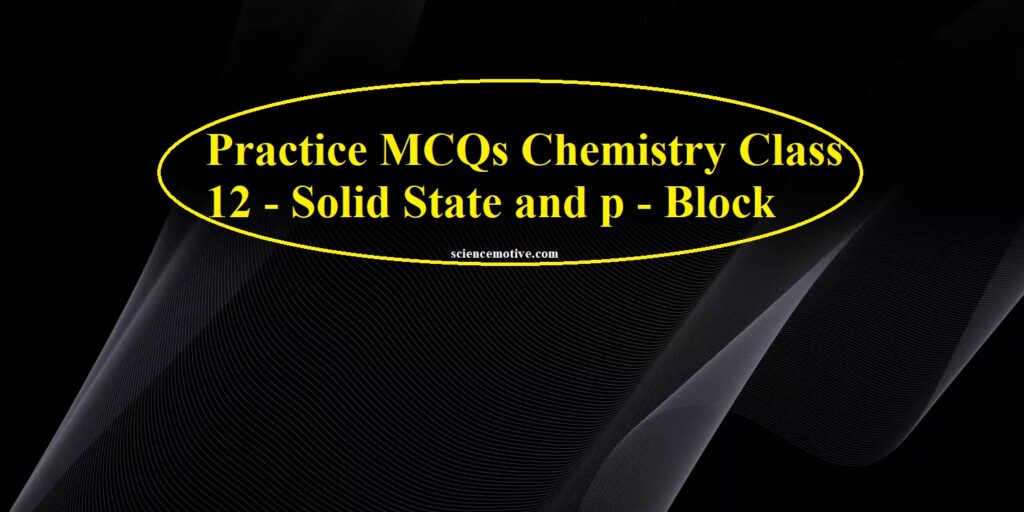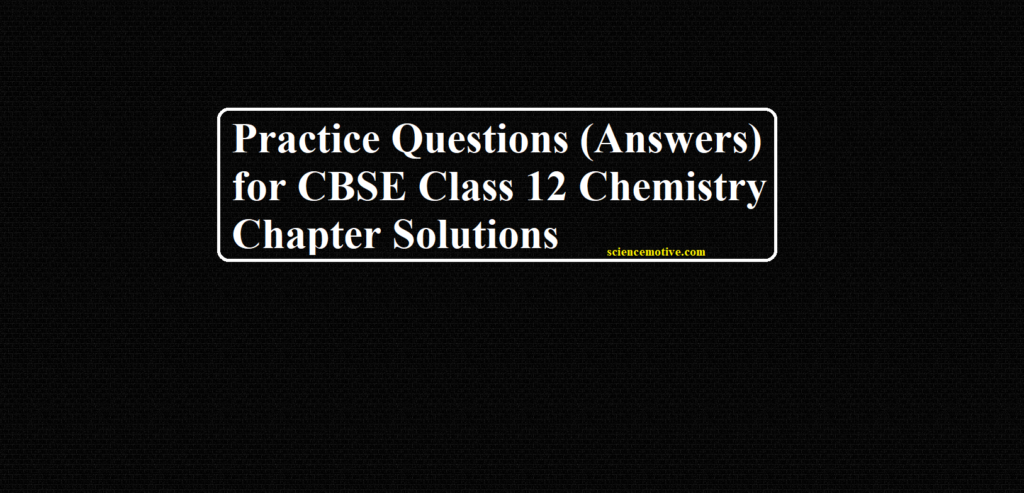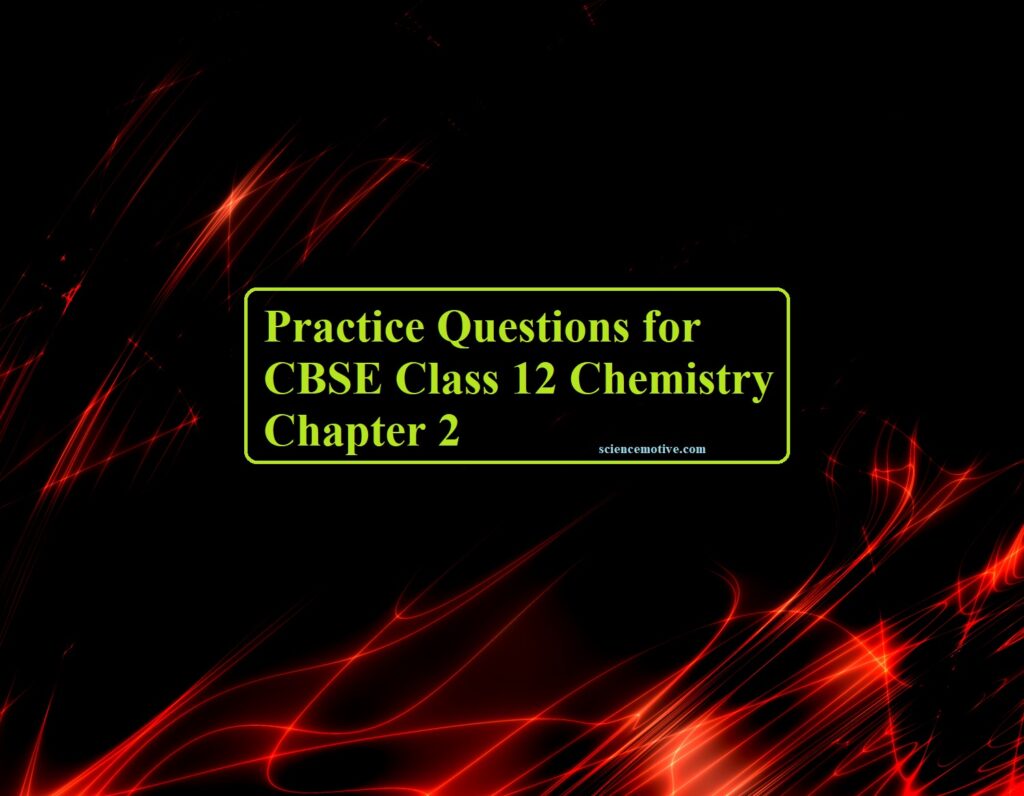Dear students solve these questions and then check your score. To get answers for the post Practice MCQs Chemistry Class 12 – Solid State and p – Block click the link given at the end of the post
Practice MCQs Chemistry Class 12
Practice MCQs Chemistry Class 12
Que 1. Solid carbon dioxide is an example of
(a) Ionic crystal
(b) Covalent crystal
(c) Metallic crystal
(d) Molecular crystal
Que 2. In a simple cubic unit cell, an atom at the corner contributes to the unit cell
(a) 1 part
(b) 1/2 part
(c) 1/4 part
(d) 1/8 part
Que 3. The vacant space in the bcc unit cell is
(a) 32 %
(b) 23 %
(c) 26 %
(d) None of these
Que 4. If an atom is present at the center of the cube, the contribution of that atom per unit cell
(a) ¼
(b) 1
(c) ½
(d) 1/8
Que 5. What is the coordination number in hcp lattice
(a) 4
(b) 6
(c) 10
(d) 12
Que 6. In a fcc unit cell, the contribution from the atom at the corner and face center of the cube are respectively
(a) 1/4, ½
(b) 1/8, ¼
(c) 1/8, ½
(d) 1/2, 1/2
Que 7. The octahedral voids in fcc or ccp are located at
(a) Edge centers and along diagonals
(b) Edge centers and body center
(c) Along body diagonal and edge center
(d) All the edge centers only
Que 8. In a face-centered lattice of X atoms, Y atoms occupy 1/2 of tetrahedral voids and 1/4 of octahedral voids. What is the possible formula of the compound?
(a) X4Y6
(b) X4Y5
(c) X4Y8
(d) X4Y9
Que 9. In a face-centered lattice of X and Y, X atoms are present at the corners while Y atoms are at face centers. Then the formula of the compound is:
(a) XY3
(b) X2Y3
(c) X3Y
(d) XY
Que 10. A compound contains P and Q elements. Atoms Q is in ccp arrangement while P occupies all tetrahedral sites. The formula of the compound is:
(a) PQ
(b) PQ2
(c) P2Q
(d) P3Q
Que 11. In a closest packed lattice, the no. of octahedral sites as compared to tetrahedral ones will be
(a) Equal
(b) Half
(c) Double
(d) None of these
Que 12. The correct order of the packing efficiency in different types of the unit cell is
(a) Fcc < Bcc < Simple cubic
(b) Fcc > Bcc > Simple cubic
(c) Fcc < Bcc > Simple cubic
(d) Bcc < Fcc > Simple cubic
Que 13. What is the relation between edge length (a) and radius (r) in a simple cubic lattice
(a) a = 4r
(b) a = r
(c) a = 2r
(d) a = r/2
Que 14. types of Bravais lattices in 3D arrangement is
(a) 8
(b) 12
(c) 14
(d) 9
Que 15. For some crystals, the radius ratio for cation and anion is 0.525, its coordination number will be
(a) 2
(b) 4
(c) 6
(d) 8
Practice MCQs Chemistry Class 12
Que 16. Patterns of layers in ccp are
(a) ABAB type
(b) ABCABC type
(c) ABBA type
(d) ABCBACtype
Que 17. The no. of octahedral voids per sphere in an fcc lattice is
(a) 8
(b) 4
(c) 2
(d) 1
Que 18. What type of defect can arise when a solid is heated?
(a) Vacancy defect
(b) Interstitial defect
(c) Metal excess defect
(d) Impurity defect
Que 19. Which compound is added to create an impurity defect in NaCl?
(a) AgBr
(b) AgCl
(c) KI
(d) SrCl2
Que 20. Silver forms ccp lattice and X-ray studies of its crystals show that the edge length of its unit cell is 408.6 pm. Calculate the density of silver in gram per cubic cm (Atomic mass = 107.9 u).
(a) 11.5
(b) 10.5
(c) 1.05
(d) 105
Que 21. The idea that promoted to Bartlett to prepare the first-ever compound of Noble gases was
(a) Low bond dissociation enthalpy of F-F bond in F2
(b) High bond enthalpy of Xe-F bond
(c) Ionization enthalpies of O2 and Xe are almost the same
(d) None of the above
Que 22. Out of (i) XeO3 (ii) XeOF4 and (iii) XeF6, the molecules having the same number of lone pairs on Xe are
(a) (i) and (ii) only
(b) (i) and (iii) only
(c) (ii) and (iii) only
(d) (i), (ii) and (iii)
Que 23. Partial hydrolysis of XeF6 yields (i) XeO3 (ii) XeOF4 (iii) XeO2F2
(a) Only (i)
(b) (i) and (ii) both
(c) (ii) and (iii) both
(d) only (ii)
Que 24. When Xe reacts with Fluorine in 1:5 ratio at 873 K it forms
(a) XeF2
(b) XeF4
(c) XeF6
(d) XeOF4
Que 25. Which one of the following metallic hydroxides do not dissolve in sodium hydroxide solution
(a) Zn(OH)2
(b) Al(OH)3
(c) Fe(OH)3
(d) Pb(OH)2
Que 26. Which compound of Xe is explosive solid
(a) XeF4
(b) XeO3
(c) XeOF4
(d) XeF2
Que 27. Chlorine water on standing loses its yellow colour due to the formation of
(a) Cl and HOCl
(b) HCl and HOCl
(c) HOCl and HOCl2
(d) HCl and HOCl2
Que 28. Which is not correct
(a) acidic strength HF < HCl < HBr < HI
(b) Stability HF > HCl > HBr > HI
(c) H–X dissociation enthalpy H–F > H–Cl > H–Br > H–I
(d) Boiling Point- HF< HCl < HBr < HI
Que 29. Iodine is placed between two liquids C6H6 and water
(a) It dissolves more in C6H6
(b) It dissolves more in water
(c) It dissolves equally in both
(d) Does not dissolve in both
Que 30. Hypochlorous acid and perchloric acid are, respectively
(a) HOCl and HClO4
(b) HOCl and HClO3
(c) HClO2 and HClO3
(d) HClO2 and HClO4
Practice MCQs Chemistry Class 12
Que 31. Which liberates SO2 with dil H2SO4
(a) Na2SO4
(b) NaHSO4
(c) Na2SO3
(d) Na2S
Que 32. Oleum is a mixture of
(a) H2SO4 + SO2
(b) H2SO4 + SO3
(c) H2S2O3 + SO3
(d) H2S2O3 + SO2
Que 33. When conc. H2SO4 comes in contact with sugar, it becomes black due to.
(a) Hydrolysis
(b) Hydration
(c) Decolourisation
(d) Dehydration
Que 34. For decomposition of ozone
(a) ΔH = negative, ΔS = positive, ΔG = negative
(b) ΔH = positive, ΔS = positive, ΔG = negative
(c) ΔH = negative, ΔS = negative, ΔG = negative
(d) ΔH = negative, ΔS = positive, ΔG = positive
Que 35. Electrolysis of water leads to the release of
(a) Hydrogen at the cathode and oxygen at the anode
(b) Hydrogen at the anode and oxygen at the cathode
(c) Hydrogen and oxygen at the anode
(d) Hydrogen and oxygen at the cathode
Que 36. Very pure nitrogen can be obtained by
(a) Thermal decomposition of ammonium dichromate
(b) Thermal decomposition of sodium or barium azide.
(c) Liquefaction and fractional distillation of air
(d) Treating an aqueous solution of ammonium chloride with sodium nitrite.
Que 37. Which one is not a correct statement
(a) Nitrogen does not form pentahalide due to the non-availability of the d orbitals in its valence shell
(b) Pentahalides are more covalent than trihalides.
(c) In the case of nitrogen, only NF3 is known to be stable
(d) Trihalides except BiF3 are predominantly ionic in nature
Que 38. The oxide in the higher oxidation state of the element is ———acidic than that of the lower oxidation state.
(a) More
(b) Less
(c) Can’t predict
(d) None of the above
Que 39. Which is not the correct order?
(a) Reducing character: NH3 < PH3 < AsH3 < SbH3 < BiH3
(b) Basic property: NH3 >> PH3 >> AsH3 > SbH3 > BiH3
(c) Boiling point: BiH3 > SbH3 > NH3 > PH3 > AsH3
(d) Melting point: SbH3 > AsH3 > PH3 > NH3
Que 40. There is a considerable increase in covalent radius from N to P. However from As to Bi only a small increase in covalent radius is observed. This is due to
(a) Increase in number of shells
(b) Increase in valence electrons
(c) Increase in ionization enthalpy
(d) The presence of completely filled d and/or f orbitals
Practice MCQs Chemistry Class 12



